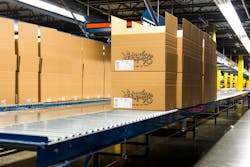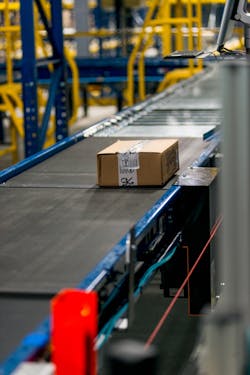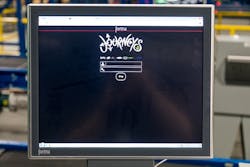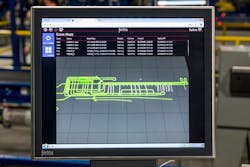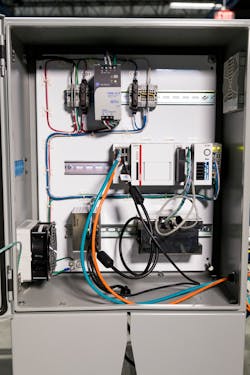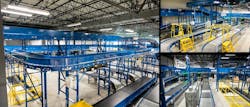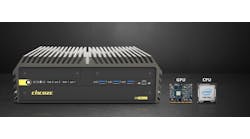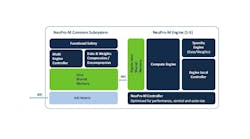Journeys expands warehouse capabilities to keep pace with e-commerce acceleration
Nearly a quarter of the Earth’s population buys at least some goods and services with mouse clicks instead of shopping trips. This rate will increase, surpassing 2 billion online shoppers worldwide by 2020, according to research from Statista. In this shifting landscape, retailers must design better websites to place orders and better warehouse systems to fulfill them quickly and cost effectively.
To increase shipping capabilities, the Journeys distribution center in Lebanon, Tennessee, hired Fortna for a recent warehouse expansion project (Figure 1).
Figure 1: The Journeys distribution center in Lebanon, Tennessee, supports order fulfillment for hundreds of stores and the footwear retailer’s growing e-commerce presence.
Journeys, a retailer of young adult footwear brands from Adidas and Fila to Converse and Vans, has successful brick-and-mortar stores across the United States. However, growing e-commerce sales have forced the company to modernize its distribution strategy (Figure 2).
Figure 2: Growing e-commerce sales have forced the company to modernize its distribution strategy.
Fortna and Journeys first partnered in 2000 to design and implement a 320,000-sq-ft distribution center, which would support 800 stores with an annual throughput of 17 million SKUs. However, the online shopping boom since then has forced the distribution center to fulfill large quantities of same- or next-day orders. This prompted Journeys and Fortna to begin planning a major warehouse expansion in 2015 and implement the renovations in 2017, explains William King, group vice president of integrated technology solutions for Fortna (Figure 3). “We increased the distribution center’s capacity by adding a new conveyor and picking system during the expansion project,” King says. “As part of that, we upgraded the warehouse control using our FortnaWES warehouse execution system (WES) software and the supporting hardware.”
Figure 3: Prior to the 2017 expansion, Journeys and Fortna teamed up in 2000 for the original design and implementation of the Lebanon, Tennessee, warehouse.
Fortna designs, implements and supports distribution solutions, including advanced automated systems and its WES software, for companies across the globe (Figure 4). Headquartered in West Reading, Pennsylvania, the company has locations throughout North America, as well as in Mexico, Colombia, Vietnam, the United Kingdom and South Africa.
Figure 4: Fortna designs, implements and supports distribution solutions, including advanced automated systems and its WES software, for companies across the globe.
Founded in 1946, Fortna originally sold pallet jacks and forklifts but shifted to conveyors and automated systems when Chairman Peter Counihan assumed leadership in 1988. Fortna helps customers to implement innovative controls technology while leveraging legacy systems for better results.
“Our goal is to give clients and their distribution operations a competitive advantage,” King explains. “Our services range from helping companies define their distribution strategy to designing, implementing and supporting their distribution-center operations via turnkey offerings.” The Journeys warehouse expansion required all of these aspects.
Changing landscape requires next- or same-day shipping
Among the many challenges in today’s e-commerce environment, minimizing the time between placing an order and delivering it to the customer’s door tops the list. For distribution centers, this requires ever-increasing levels of automation, networking and control.
High-speed sorters and merges must handle more than 130 cartons per minute with incredible accuracy, because just one mistimed carton could jam a conveyor and bring the entire operation to a halt, and operations like the Journeys warehouse simply cannot tolerate unplanned downtime.
Order fulfillment even continued during the warehouse expansion, says Jeremy Davidson, director at Fortna. “This implementation required a challenging combination of seamless equipment transition, continuous operation throughout the rollout, zero operational impact and minimal service interruption,” Davidson says.
As large distribution centers from Journeys and other retailers increase their reliance on the Internet, they must further harden security. Any unapproved access into the distribution system, whether a data breach or interference with the controls, could lead to a major slowdown or stoppage of distribution. “Security has rightly become a key area of focus,” King says. “Fortna puts considerable effort into making our systems more secure. Our clients can rest assured that our highly connected systems minimize risks.”
The system architecture also needed to support open communication across the warehouse to all controls and field devices. Because so many warehouse operations constantly play catchup with the quick turnaround demanded by e-commerce, many businesses cannot spend the time, much less the expense, to replace entire distribution systems with equipment from the same manufacturer.
Cross-vendor communication is a point of pride for Fortna, explains King. “Our software is hardware-agnostic, allowing us to purchase and commission best-of-breed sorters, conveyors, merges and other equipment from a variety of vendors,” he says. “That’s one of our key differentiators.”
System openness is also a key feature of Beckhoff Automation hardware and software solutions, leading Fortna to standardize on Beckhoff for all new installations. “The open architecture and support for both EtherCAT and legacy fieldbuses, including EtherNet/IP, was a fundamental factor in Fortna’s success with Beckhoff technology,” says Doug Schuchart, vertical manager of material handling and logistics for Beckhoff USA. “This allowed Fortna to utilize new PC-based control technology in a multi-phase approach, first adding Beckhoff controllers to run the legacy software, then upgrading to EtherCAT for fieldbus devices and finally implementing complete TwinCAT automation software solutions.”
Automation solutions deliver the results in warehouse expansion
Fortna offers hardware and software for upgrades and new solutions with additional features by leveraging open platform solutions from Beckhoff Automation. Fortna first adopted Beckhoff TwinCAT 3 automation software as an engineering platform to design the new controls layer for its WES (Figure 5). The result, Fortna Real-Time Controls (FRC), replaced the company’s 25-year-old FortnaPlus software, a C+ program running on the QNX operating system.
Figure 5: FortnaWES warehouse execution system (WES) software is configurable to each company’s application requirements.
“The new FRC represents a significant improvement,” says King. “When we first started working with Beckhoff, our end goal was to migrate to a new controls platform and to leverage new Beckhoff PC-based control hardware, EtherCAT I/O and TwinCAT 3 software for engineering and runtime.”
Fortna drove the convergence of a number of warehouse solutions to enhance the Journeys distribution center, but one of the key aspects was FortnaWES, a warehouse execution software product that Fortna designs, develops and implements in-house. This system relies on the flexibility of TwinCAT 3 and the openness of Beckhoff PC-based controls, which support any software that can run on a PC.
TwinCAT TCP/IP is particularly important for WES, explains King. “Ethernet TCP/IP is the protocol that allows our FRC controls layer to talk to our business layer in real time to process thousands of transactions per hour,” he says. “Any time we scan a carton at a sorter, for instance, the controls layer asks the business layer, ‘Where should this go?’ The business layer, which contains the logic, may respond, ‘Take it to Lane 6.’ That happens in hundred-millisecond timeframes, and TwinCAT TCP/IP makes it possible.”
Operators on each line interface with FortnaWES through a 19-inch CP3919 multi-touch control panel (Figure 6).
Figure 6: Operators on each line interface with FortnaWES through a multi-touch control panel.
In many applications, Fortna mounts a Beckhoff multi-touch panel directly to the control cabinet, but in Journeys’ case, it made sense to pole-mount the HMI next to each conveyor line and use CP-Link 4, the One Cable Display Link, to transmit USB 2.0 signal, DVI signal and power from a nearby cabinet (Figure 7).
Figure 7: The custom distribution solution that Fortna designed and implemented includes a pole-mounted multi-touch control panel.
Both the software and HMI run on a Beckhoff CX2030 embedded PC with a dual-core, 1.5 GHz Intel Core i7 processor (Figure 8). The embedded PC offers greater functionality while reducing complexity, which helps engineers familiar with PLC hardware formats to adapt to a Windows-based system. “Many in the material handling and distribution industries are still locked in the PLC mindset,” King says. “Delivering an industrial, PC-based controller that mounts on DIN rail inside the electrical cabinet like a PLC provides a robust solution.”
Figure 8: A compact embedded PC runs FortnaWES warehouse execution system (WES) software while controlling conveyors, merges and other equipment.
Using EtherCAT as the industrial Ethernet fieldbus, Fortna is able to leverage distributed I/O concepts. “EtherCAT was a compelling technology for Fortna from the beginning due to its wide acceptance in the logistics industry,” Schuchart says. “It possesses the unique capability to support up to 65,000 devices on a single network over vast fulfillment centers with flexible topology and network speeds in the realm of microseconds.”
The compact EtherCAT terminals save cabinet space while offering a higher level of performance, says King. In addition, the open system facilitates communication among new equipment and legacy systems, helping Fortna to remain flexible in its equipment selection. “We bring much more to the table by remaining hardware-agnostic in distribution systems design,” King says. “Implementing robust automation solutions from Beckhoff only sharpens our competitive edge.”
Distribution system optimized for e-commerce
The Journeys distribution center expansion went live in April 2018. This project resulted in an increase in storage capacity, an overall increase in carton throughput and the ability to efficiently fulfill e-commerce orders (Figure 9). “To enable this transformation, Journeys called on Fortna to collaboratively define the strategy and business case to justify the project,” Davidson says. “In addition, Journeys and Fortna developed an integrated design and implementation plan to achieve the expected results and uphold great service to their in-store and online customers.”
Figure 9: The project resulted in an increase in storage capacity, an overall increase in carton throughput and the ability to efficiently fulfill e-commerce orders.
By implementing EtherCAT and PC-based control solutions, Fortna has been able to speed up its commissioning times and decrease downtime for new implementations. To minimize downtime during the migration, Fortna installed an extra CX2030 embedded PC near the main line controller. This enabled the operator to simply move the Ethernet cable and CFast flash memory card to the new unit as needed.
During the Journeys expansion project and many others Fortna has completed for clients in the retail, apparel, automotive and pharmaceuticals industries, Beckhoff has proven to be an excellent fit for reasons beyond equipment quality and reliability.
“The Beckhoff sales and support teams are exceedingly helpful, and it is reassuring for Fortna and its international customers to have a vendor with locations in the same regions around the globe,” King says.
The unique direct sales approach and global reach of Beckhoff strengthened the companies’ working relationship, Schuchart explains. “This not only provided Fortna the support it required, but also boosted the company’s confidence in Beckhoff as a full-service automation partner, not simply a component manufacturer,” he says.
All of these factors help Fortna to provide greater value to repeat customers and attract new ones through its proven ability to make modern e-commerce work with advanced distribution solutions. “We are always looking for new and more innovative solutions that allow our clients to successfully compete in today’s demanding e-commerce world, decrease their risk, drive efficiency and also drive down costs,” King says. “We are trying to become even more competitive in our marketplace by finding new solutions that are more efficient, powerful and cost-effective. We have increased our abilities in all of those areas with Beckhoff.”
Latest from Embedded Control

Leaders relevant to this article:

